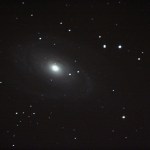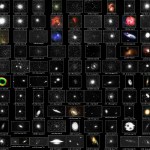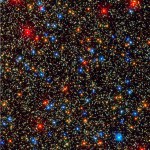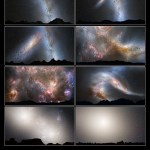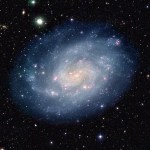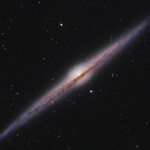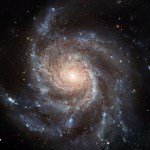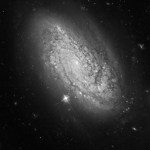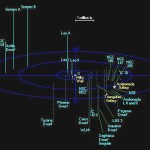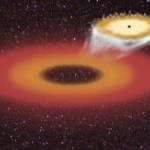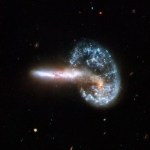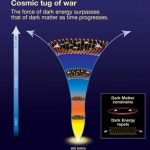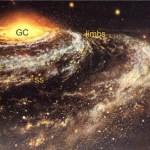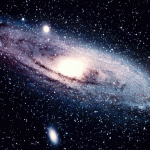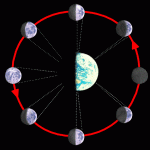galaxy
"The vastness of the heavens stretches my imagination. It does not do harm to the mystery to know a little about it. For far more marvelous is the truth than any artists of the past imagined it." -Richard Feynman
What did you think about, wonder about, and dream about the first time you saw the true magnificence of the night sky? Did you wonder about planets orbiting each of the thousands of points of light you saw? Did you think about the possibilities of rocky worlds with liquid water, of life, and even of intelligent aliens? Or did you perhaps think on even larger scales, about what stars…
"When you look at the stars and the galaxy, you feel that you are not just from any particular piece of land, but from the solar system." -Kalpana Chawla
Welcome to this week's Messier Monday, where I pick a new object out of the original catalogue of 110 "faint fuzzies" designed to help comet-hunters avoid confusion with these fixed, extended night sky objects.
Image credit: The Messier Objects by Alistair Symon, from 2005-2009.
In previous weeks, we've focused on a variety of objects, including a globular cluster, an open star cluster, a supernova remnant and an active star-forming nebula…
"When your friends begin to flatter you on how young you look, it's a sure sign you're getting old." -Mark Twain
Welcome to yet another installment of Messier Monday, where each week, I'll pick one of the 110 Messier Objects -- deep-sky objects catalogued to avoid confusion for comet hunters -- to highlight for you.
Image(s) credit: SEDS -- http://messier.seds.org/.
So far, we've taken a look at a supernova remnant, a young open star cluster, and an active star-forming nebula, a testament to the great diversity of these faint, fuzzy objects that might be easily confused with a…
"It's a brilliant surface in that sunlight." - Neil Armstrong
Indeed, all that glitters so brilliantly in the cosmos does so because of the stars that have formed throughout it.
Image credit: NASA, ESA, and the Hubble SM4 ERO Team.
Over the 14 billion-or-so years that our Universe has been around, we've formed hundreds of billions of stars in our galaxy alone.
Image credit: ESO / Serge Brunier (TWAN), Frederic Tapissier.
Given that our galaxy is just one of at least hundreds of billions in the observable Universe, the number of stars that have formed over our Universe's history is a…
"It is always wise to look ahead, but difficult to look further than you can see." -Winston Churchill
We've come a long way in this Universe. Over the past 13.7 billion years, we've formed the light elements out of a sea of protons and neutrons, cooled and expanded to form neutral atoms for the first time, gravitationally collapsed hydrogen and helium gas clouds to form the first stars, borne witness to generations of stellar deaths and rebirths, lived through the formation of hundreds of billions of galaxies and the clustering together of thousands or more galaxies into clusters, filaments,…
"We don’t understand how a single star forms, yet we want to understand how 10 billion stars form." -Carlos Frenk
The Universe has been around for a long time: nearly 14 billion years, to the best of our knowledge. When it was very young, there were absolutely zero stars in it, while today, there are hundreds of billions of galaxies, each of which contains anywhere from a few billion to many trillions of stars.
Image credit: NASA, ESA, and the Hubble Heritage (STScI / AURA) - ESA / Hubble Collaboration
The galaxy shown above, NGC 2841, is very similar to our own Milky Way.…
"Black holes, which have no memory, are said to contain the earliest memories of the universe, and the most recent, too, while at the same time obliterating all memory by obliterating all its embodiments. Such paradoxes characterize these strange galactic monsters, for whom creation is destruction, death life, chaos order." -Robert Coover
Our Milky Way, the swath of light and dark that dominates the darkest skies here on Earth, contains a huge variety of stars: large and small, red and blue, from young to old to ancient.
Image credit: ESO / Serge Brunier, Frederic Tapissier, The World At…
"If you don't like what you're doing, you can always pick up your needle and move to another groove." -Timothy Leary
Up in the night sky, shortly after sunset, the night sky holds some spectacular sights. Some are permanent, some are transient, some have been known for thousands of years, and some are still being discovered. Looking to the west after sunset tonight, this is what you're likely to see.
Image credit: Me, using Stellarium, available free at http://stellarium.org.
The Big Dipper, perhaps the most famous collection of seven stars in the night sky, looms large over the horizon. As…
"This seems to be the law of progress in everything we do; it moves along a spiral rather than a perpendicular; we seem to be actually going out of the way, and yet it turns out that we were really moving upward all the time." -Frances Willard
As spring gives way to summer here in the Northern Hemisphere, one of the most beloved sights of the night sky becomes ever more prominent: the Big Dipper.
(Image credit: NASA, ESA, Z. Levay (STScI) and A. Fujii.)
These seven bright stars shine high above the horizon after sunset, and will continue to do so over the rest of the Spring and all Summer…
Dark matter - that invisible stuff that is supposed to make up some 20% of the Universe - was thought up to explain a puzzling observation. The amount of mass we can see through our telescopes is not enough to keep galaxies from spinning apart. The existence of great quantities of hidden mass would provide the gravitational pull needed to form those galaxies and enable them to rotate in the way that they do.
But not everyone is willing to buy the idea that the Universe is cloaked in "invisible cloth." An alternate theory, first put forward by Weizmann Institute astrophysicist Prof. Moti…
tags: Galactic Center of Milky Way Rises over Texas Star Party, astronomy, science, stars, Milky Way, streaming video
This fascinating video is a time lapse video of night sky as it passes over the 2009 Texas Star Party in Fort Davis, Texas. In this video, you will see the bright galactic core of the Milky Way crossing the Texas sky. Images taken with 15mm fisheye lens.
Some of you who've been following astronomy for awhile might remember this report, where a group of astronomers reported finding a giant "void" in the Universe.
What is a void? Well, galaxies are distributed pretty randomly, but because of gravity, they cluster together. A small example is our local group which looks like this,
and a larger example is the Virgo cluster, which is about 1,000 times as massive as our local group, and looks like this:
Well, a void is the opposite of a cluster, where you have a large volume of space that's simply empty of galaxies and matter. This press release…
No, not because it was too young to drink! Scientists at the Max Planck Institute for Extraterrestrial Physics were looking at some X-ray objects, and discovered something really weird: a very bright X-ray source moving out of a galaxy at nearly 3,000 kilometers/second! This thing is a goner. If our Sun were moving at even one quarter of that speed, it would get thrown out of our galaxy.
Now, here's the kicker: this isn't just any old object getting tossed out of a galaxy, it is a huge black hole! How huge? About 300,000,000 times the mass of our Sun. You read that number right: 300,000,000…
(Thanks to Starts With A Bang! reader benhead.) The Hubble Space Telescope has released some beautiful images of colliding galaxies in a huge collection! Here are some of my favorites, with my very own names for them (real name in parentheses).
We'll start with the Glowing Arrow (Arp 148):
The Highway Windshield (NGC 6240)
The Flaming Splinter (NGC 6670):
And finally, I call this one "my new desktop wallpaper:"
I was going to write a whole bunch about this, but I have been beaten to the punch by Universe Today, Bad Astronomy, and Will Gater. I'll have to wake up earlier next time! In the…
What is the future of this website? I'm going to be creating videos for the web about the Universe. I'll be answering questions ranging from what the Universe is like today to how it got to be that way. I'm going to address every step that we know of, from the Big Bang up to the present day.
And I'm going to do it naturally, by telling the story as the Universe tells it directly to us. I call this project Genesis. Check out the teaser trailer below, and tell your friends, because this is coming in January.
In a comment on my last post, What is Dark Energy, Kendall asks the following, which is such a good one I think it deserves its own post:
I thought the expansion was accelerating? Aren’t you saying that it is on its way down to 85% of its current rate? Sounds like expansion is slowing, but still leaves us with an open universe…
People do say the expansion of the Universe is accelerating. But that doesn't mean that the expansion rate is accelerating. It means that if you take a look at any one galaxy that isn't gravitationally bound to us in the Local Group (that is, any big galaxy that isn't…
So last week I was up at Pacific University in Portland, OR for a job interview. As part of a faculty interview, you have to lecture on a topic for undergraduates, but they give you the topic just a couple of days before. My topic was Gauss' Law, which talks about the relationship between an Electric Field and an Electric Charge. Well, the same law holds for Newton's theory of Gravitation with a gravitational field instead of an electric field and a gravitational charge (i.e., mass) instead of an electric charge.
So I'm at work today thinking about this, doing the thing I do messing around…
Cameras, CCDs, prisms, grisms, etc., are all some of the instruments that can go on top of telescopes to help us see things better. We haven't really increased the size of telescopes so much as we have the quality and ability of the apparatus that go atop them. Take a look at various pictures I've stolen off the web, all taken by (avid) amateur astronomers in different years. The pictures are of M81 and M82, two galaxies in a group that make up possibly the nearest cluster of galaxies outside of the local group. (The closest is either the M81 group, the Centaurus group, or the IC 342 group.)…
The Milky Way galaxy is a relatively big spiral galaxy. So is Andromeda. There are about 20 dwarf galaxies that are gravitationally bound to us; combined with us, all of this makes up the local group. But Andromeda is moving towards us, and eventually, it's going to merge with us. I'll once again show you a video of what this merger might look like:
But what would we see, here in the Milky Way, as Andromeda got closer and closer to us? Right now, Andromeda looks like this:
But Andromeda is also very far away: about 2.3 million light years (770 kpc). The center of it is tiny on the sky, but…
The Moon goes around the Earth, the Earth goes around the Sun, and the Sun goes around the center of the Milky Way. We know the Moon takes about 4 weeks to make its trip around the Earth, and that causes the Moon phases:
We also know that the Earth takes one year to go around the Sun, and that causes the seasons:
We also know that the Earth has been around for about 4.5 billion years, which means it has gone around the Sun about 4.5 billion times. Well, now I ask the question(s):
How long does it take the Sun to go around the Milky Way? How many times has it done that so far, and how many…

